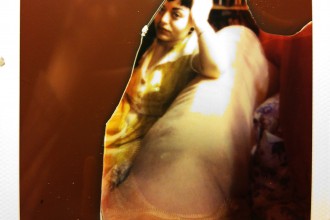Donna Haraway describes the cyborg in “The Cyborg Manifesto” as a biotic system in a post-gender world, and a creature of social reality and fiction. This cyborg is closer to the Ball Room losers than to the winners. The defeated give us the opportunity to discuss ways of being female, male, heterosexual, homosexual, transgender, bisexual, pansexual, individual, or whatever version of ‘human’ we can imagine. When the losers parade on the catwalk, they try to simulate femininity “as it should be”. At this moment, what we imagine to be a ‘being-woman-heterosexual’ becomes disrupted by their inability to win, and in that way these competitors resist the oppressive forms of femininity. Intimate prosthetic devices, such as fake tits and mascara, redefine their bodies in the failure of a successful definition of femininity, and amplify the scope of how we think gender. The communication devices became my limbs. The situation I was exposed to redefined my body in such a drastic way that after the relationship ended I felt phantom pain in my amputated prosthetic members. The pain would remind me that I was not using my iPhone for its intended purpose. Power has infiltrated the body of the winners, but those unable to win have shown that desire was not enough and therefore shaped power in their bodies into a quasi-erotic dialectic. What happens to the significance of desire, lack of recognition, and dignity? Perhaps desire only allows dominant categories of being, but these categories are so oppressive that they become a sort of golden cage. However, in the bodies of the losers this type of desire does not really exist, which raises the question: why do men desire their own enslavement? The significance of desire was achieved in our bodies, but frugally in order to not transform it into an everlasting state of mind. Eventually our hetero-normative system of belief readapted our desires into different ones. But for the moment when our minds were one I loved him, and I was his Grace Kelly. Those who have not won are our liberators, they began a path in which the separation between reality and fiction became blurred, and in which prosthetic technology was used to achieve that blur. New technologies alter our bodies because they allow new forms of power to penetrate us and allow us to invent new forms of desire. We are all cyborgs since we belong to a biotic system, which forces us to separate reality from fiction. The losers, those knights in shining armour, ultimately dissolve this dichotomy in our bodies. They are the cyborg monsters that prevent the assembly of a golden cage in which we are supposed to be happy, and are the true pioneers of new forms of political possibilities for the male/female fiction. The dichotomy between reality and fiction ruptured the relationship. We were living a construction based on written words that eventually would end up meaning nothing. I forgot his voice; I do not remember it anymore. I will never forget how I felt when my cyborg body became useless for love. Being the loser in the relationship was liberation at its most beautiful. Those ballroom losers have achieved, unwittingly perhaps, the real oppositional consciousness that Haraway refers to as the ability to understand power in all its subtlety, given the impossibility of belonging to an established category. But while directing Paris is Burning, Livingston and her camera helped me to understand that a cyborg body does not end in the skin of the individual or in the breast implants that violently define what it means to be an object/subject. A cyborg body begins in the body of the individual and extends to the camera’s record button, so we remember who the real knights are.
Words by Ignacio
Edited by Louise Trueheart
Illustration by Judy Mièl
Have you read these?
TECHNOLOGIES FOR LIBERATION (PART I)
TECHNOLOGIES FOR LIBERATION (PART II)








